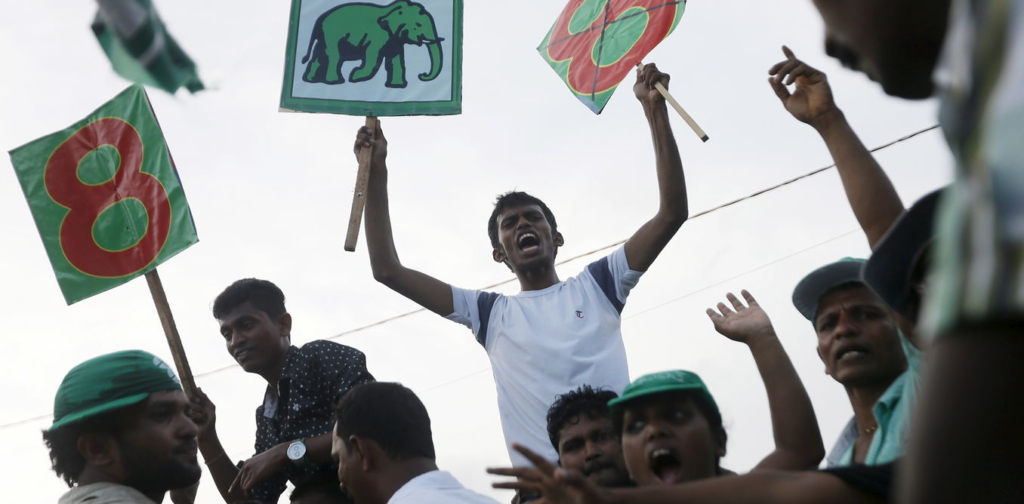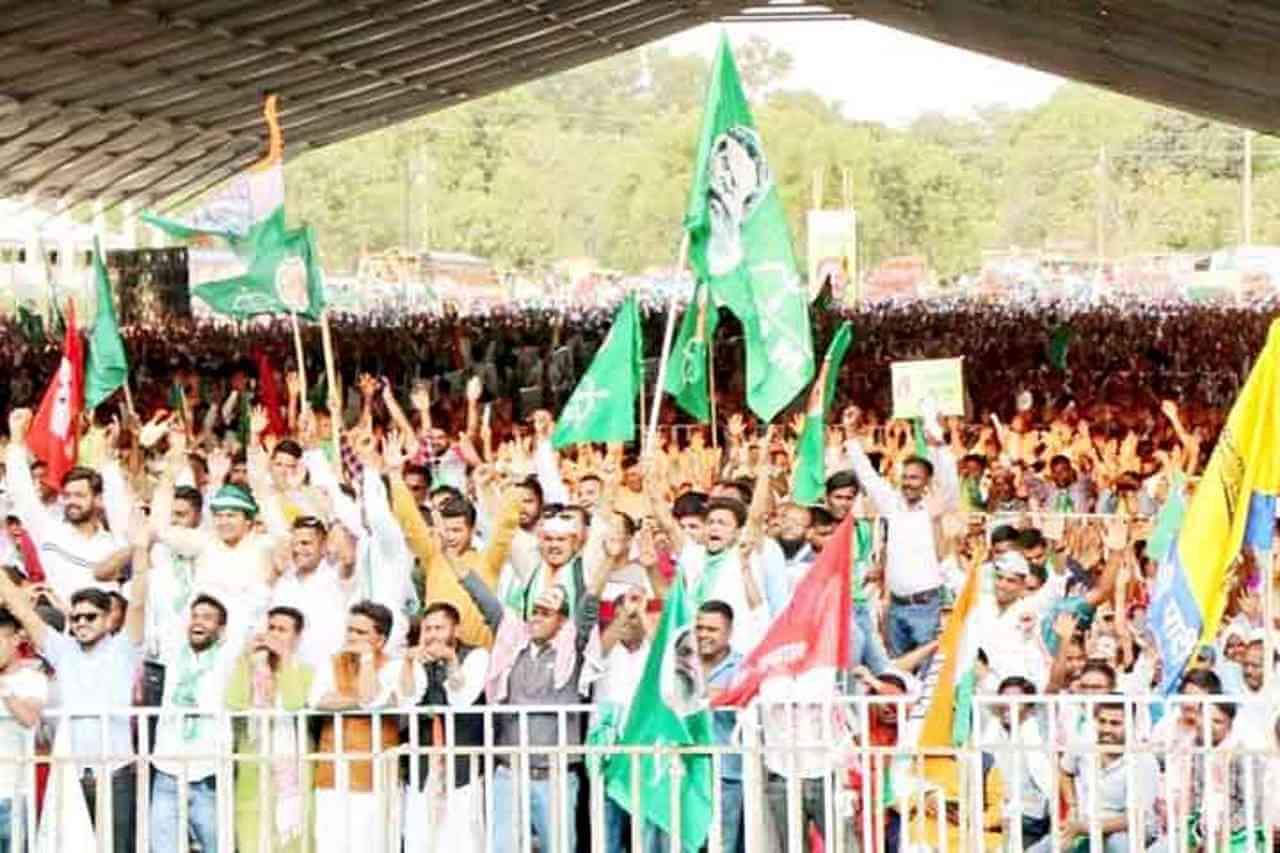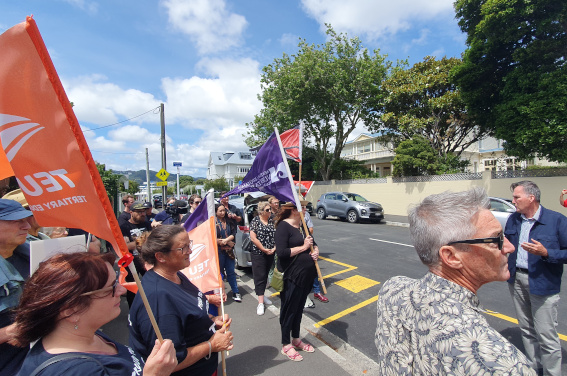This piece was first given as a talk at the Te Whanganui-a-Tara branch of the International Socialist Organisation
To understand the political situation in Sri Lanka we must first understand the historic past of the peoples of Sri Lanka, formerly Ceylon under the British empire. I say peoples because even to this day they are not of a united identity – it was just 20 years ago that the country was in civil war. This review will discuss the history of the peoples of Sri Lanka leading up to the current situation, and then the news so far from the country during the wave of protests in the first half of 2022. The source for the history of this island nation is from Encyclopaedia Britannica, and news of the current affairs was collated from Al Jazeera and word of mouth from workers in New Zealand who have families currently living in Sri Lanka.
Sri Lanka had its first huge influx of migrants in the 5th BCE, and these people took the identity of Sinhalese and are thought to be from the southern Indian mountains. The next migration brought the Tamil, who are thought to be from central, eastern, and southern India based on their Dravidian language. There was also a steady migration of Muslims, but overall the population proportion leaned heavily in favor of the Sinhalese. The population by the 10th century AD was three quarters Sinhalese, a little over one sixth Tamil, and a little over one thirteenth Muslim, plus a small number of other ethnicities. In terms of religion the Sinhalese were mostly Buddhist and the Tamil mostly Hindu. Sri Lanka has a long and rich history, but for this piece we will be focusing on what turned Sri Lanka into what it is today: its colonial history, and what followed.
Sri Lanka was first colonised between 1505 and 1658 by the Portuguese who saw how valuable the island was for its exploitable resources of elephants and cinnamon. They soon set up systems to extract these resources for themselves. The next colonisers were the Dutch, who controlled the island from 1658 to 1798 – this was the beginning of the coffee trade in Sri Lanka that would come to define the country for a little while. The last to rule Sri Lanka were the British, 1798 to 1900, and they changed the name to Ceylon. Although it didn’t attain its independence until February 1948, Sri Lanka saw massive changes to its economy during British rule. During the first half of the 1800s coffee was the major crop but by the 1870s a leaf disease had killed the cocoa trees and forced Sri Lanka to use tea as its major export, alongside rubber and coconuts.
The first party to come to power in the new government that was formed in 1948 was the United National Party (UNP). This party represented the Sri Lankan bourgeoisie, and began to form a divide between the ruling elite and the proletariat. This enabled Sinhalese nationalists to take the forefront in 1956 with S.W.R.D. Bandaranaike at the head of the Sri Lankan Freedom Party (SLFP). Bandaranaike immediately ruled Sinhalese should be the only language of the country, and promoted Sinhalese culture and Buddhism through the Sinhala Only Bill. This move alienated the large population of Tamil people that lived on the island, and would not be forgiven quickly.
Bandaranaike’s cultural reforms led to his assassination in September of 1959. Following this, the country didn’t have a government until his wife, Sirimavo Bandaranaike, re-formed the old government and re-established itself in 1960, making her the first female prime minister. She led a strong anti-Christian movement, as it was seen as attacking Buddhism and the schooling system. Although she did nationalise many private schools which effectively made education more accessible to the broad public, her goals were the continuation of the plan her husband had set out – Sinhalese nationalism. The UNP won power again in 1965, with the support of the minorities, and used their five-year term to increase agricultural productivity, but also increased inequality and inflation. For the next election, Sirimavo Bandaranaike allied with Marxist parties and called for more state control over the economy. She won a landslide victory and began reforms which increased the overall nationalisation of industries, reduced inequality, and elevated the living standards of the impoverished. Many did not believe the changes were occurring fast enough, however, and there was an armed rebellion in 1971 led by the educated youth under the name People’s Liberation Front. This rebellion was unsuccessful.
In 1972, SLFP changed the name of the country back to Sri Lanka (it had been Ceylon since British rule) and got rid of the governor-general, replacing him with a president. Sinhalese culture was once again at the forefront, and the country’s national language was once again Sinhala. Unfortunately, the party grew to nepotism and corruption, and by 1977 unemployment had risen to 15%. This led to a reorganised UNP coming back to power in 1978 under J.R. Jayawardene. To kick things off he introduced a new constitution and tried to attract more foreign investment. He also made the president head of state and gave the position new executive power as head of the government. He then became president in the same year and made Ranasinghe Premadasa his Prime Minister. He did recognise both Sinhala and Tamil as national languages, but the official language remained Sinhalese. Although this was a step forward, the Tamil felt they were under-represented and a number of Tamil groups began organising for insurgency in the jungle areas on the northern and eastern sides of the island. The biggest of them all was the Liberation Tigers of Tamil Eelam (LTTE) but that didn’t mean they all shared the same goals, and fighting amongst these groups was rife. An organisation from southern India present in the region called Tamil Nadu also saw similar organising and supported the other insurgent groups. These were the flames that fuelled the Civil War which started in 1983.
In response to the growing organisation of the not-yet active insurgents, the government deployed armed forces to these regions, which was the first step towards beginning the insurgency, and the anti-Tamil riots in Colombo and other Sinhalese majority areas. These riots were taken up by Sinhalese communal groups that formed mobs and attacked and destroyed Tamil property, forcing them to either leave the island to Tamil Nadu or move to the center of the island where the insurgents were. This led to open civil war with only a brief period of ceasefire in 1987 and another brief cease-fire in 2002. The civil war didn’t end until 2009. During the cease-fire periods, however, India made inroads into Sri Lankan politics and set up the Indian peace-keeping force to help deal with LTTE, but all this did, in the end, was give more enemies for the insurgents to shoot at.
The civil war ended when the last stronghold of the Liberation Tigers of Tamil Eelam was taken by government forces. The Tigers had been losing for a while and, after being dubbed a terrorist organisation by the European Union in 2006, their chances of gaining wider support diminished. The civil war directly caused the deaths of 70,000-80,000 people, with many more displaced during the fighting. Later it was found that there were still around 65,000 people missing after the civil war.
We will now move to 2019, with the current affairs that now shape the island and its inhabitants. The current president is Gotabaya Rajapaksa, and the Prime Minister is his brother Mahinda. Gotabaya got into power with the support of Sinhalese on a platform purely pushing Sinhalese culture and Buddhism. Also note his family has never been forgiven for the brutality that it displayed during the civil war. They got into power without any support from the Tamil or Muslim communities, and when in power actively disadvantaged the Tamil and restricted Muslim rights wherever they could – such as refusing Muslim burial rights to COVID-19 victims. On 21 April 2019, there was a terrorist attack with 8 bombs let off in high population areas, such as schools, hotels churches, etc. This attack was claimed by ISIS, but no evidence was given to support that claim. The country was already in a bad financial state thanks to COVID-19, and the economic problem was made worse by tax cuts put into effect right before the outbreak. Sloppy management also caused problems, such as cutting costs on pesticides and fertiliser without telling the farmers. To make matters worse, the delta COVID-19 variant hit the country hard after they had survived the original variant with few cases. The war in Ukraine then helped send fuel prices sky-high. The government reacted with 12-13 hour power cuts across the whole country to save money. This led to protests which started in Colombo and went on for a full month.
The protesters were calling for Gotabaya Rajapaksa to resign, as they now saw him making all the wrong moves. There was pressure inside the government for him to resign, as he tried to reshuffle his cabinet and get rid of family members, including his brother who had resigned as prime minister. The opposition refused his offers and said they wanted him to resign as well. The opposition leader, Ranil Wickremesinghe, has already filled the position four times, never completing a term, but has been accused of corruption and not taking up opportunities for addressing the old ethnic conflicts during his previous terms.
Following a month of protests, the protesters were attacked by pro-government factions, and the protestors escalated by rioting and destroying over 100 houses belonging to the president and party members. Unlike the conflicts of the past, though, both the protesters and the pro-government mobs are Sinhalese. The Tamil and Muslim communities have been avoiding protest because of the heavily increased military presence in their communities. The country has been put under military curfew, with the government threatening that ‘violent’ protesters will be shot. As of mid June 2022, the president has indicated he intends to remain in office, but is passing amendments in an attempt to appease the protestors. It remains to be seen if this is enough to persuade them to stop
Sri Lanka is presently a very divided country. Support for any particular movement in Sri Lanka must be considered carefully, because of conflicts between the various ethnic groups. Socialists should fight for Sri Lankan working class unity across ethnic lines, and argue that in-fighting between the Sinhalese and Tamil only serves to deepen the ethnic divisions that in turn support class-based oppression. Currently, it appears the government is continuing to oppress Tamil, and the Sinhalese working class remain separated from people they should be in struggle alongside. Emancipation of the Sri Lankan working class as a whole requires the inclusion of the Tamil and Muslim communities in the struggle.









